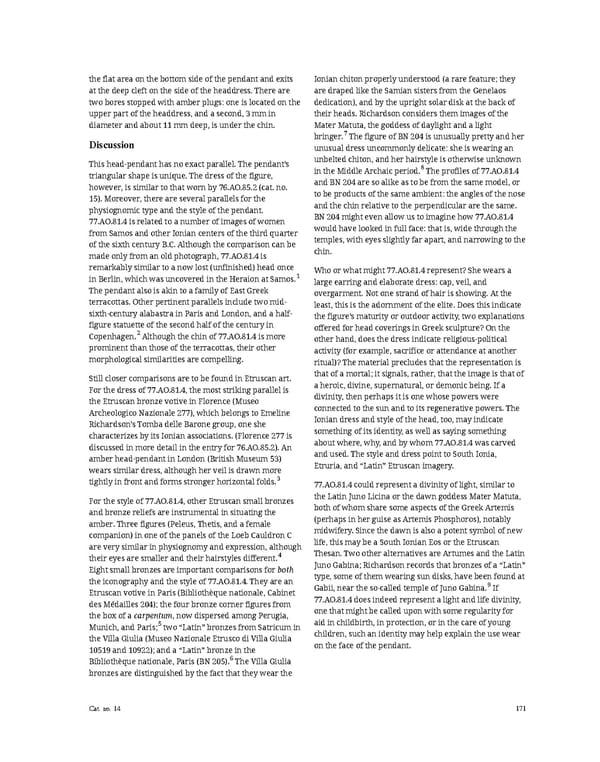the flat area on the bottom side of the pendant and exits Ionian chiton properly understood (a rare feature; they at the deep cleft on the side of the headdress. There are are draped like the Samian sisters from the Genelaos two bores stopped with amber plugs: one is located on the dedication), and by the upright solar disk at the back of upper part of the headdress, and a second, 3 mm in their heads. Richardson considers them images of the diameter and about 11 mm deep, is under the chin. Mater Matuta, the goddess of daylight and a light bringer.7 The figure of BN 204 is unusually pretty and her Discussion unusual dress uncommonly delicate: she is wearing an This head-pendant has no exact parallel. The pendant’s unbelted chiton, and her hairstyle is otherwise unknown in the Middle Archaic period.8 The profiles of 77.AO.81.4 triangular shape is unique. The dress of the figure, and BN 204 are so alike as to be from the same model, or however, is similar to that worn by 76.AO.85.2 (cat. no. to be products of the same ambient: the angles of the nose 15). Moreover, there are several parallels for the and the chin relative to the perpendicular are the same. physiognomic type and the style of the pendant. BN 204 might even allow us to imagine how 77.AO.81.4 77.AO.81.4 is related to a number of images of women would have looked in full face: that is, wide through the from Samos and other Ionian centers of the third quarter temples, with eyes slightly far apart, and narrowing to the of the sixth century B.C. Although the comparison can be chin. made only from an old photograph, 77.AO.81.4 is remarkably similar to a now lost (unfinished) head once Who or what might 77.AO.81.4 represent? She wears a in Berlin, which was uncovered in the Heraion at Samos.1 large earring and elaborate dress: cap, veil, and The pendant also is akin to a family of East Greek overgarment. Not one strand of hair is showing. At the terracottas. Other pertinent parallels include two mid- least, this is the adornment of the elite. Does this indicate sixth-century alabastra in Paris and London, and a half- the figure’s maturity or outdoor activity, two explanations figure statuette of the second half of the century in offered for head coverings in Greek sculpture? On the Copenhagen.2Although the chin of 77.AO.81.4 is more other hand, does the dress indicate religious-political prominent than those of the terracottas, their other activity (for example, sacrifice or attendance at another morphological similarities are compelling. ritual)? The material precludes that the representation is Still closer comparisons are to be found in Etruscan art. that of a mortal; it signals, rather, that the image is that of For the dress of 77.AO.81.4, the most striking parallel is a heroic, divine, supernatural, or demonic being. If a the Etruscan bronze votive in Florence (Museo divinity, then perhaps it is one whose powers were Archeologico Nazionale 277), which belongs to Emeline connected to the sun and to its regenerative powers. The Richardson’s Tomba delle Barone group, one she Ionian dress and style of the head, too, may indicate characterizes by its Ionian associations. (Florence 277 is something of its identity, as well as saying something discussed in more detail in the entry for 76.AO.85.2). An about where, why, and by whom 77.AO.81.4 was carved amber head-pendant in London (British Museum 53) and used. The style and dress point to South Ionia, wears similar dress, although her veil is drawn more Etruria, and “Latin” Etruscan imagery. tightly in front and forms stronger horizontal folds.3 77.AO.81.4 could represent a divinity of light, similar to For the style of 77.AO.81.4, other Etruscan small bronzes the Latin Juno Licina or the dawn goddess Mater Matuta, and bronze reliefs are instrumental in situating the both of whom share some aspects of the Greek Artemis amber. Three figures (Peleus, Thetis, and a female (perhaps in her guise as Artemis Phosphoros), notably companion) in one of the panels of the Loeb Cauldron C midwifery. Since the dawn is also a potent symbol of new are very similar in physiognomy and expression, although life, this may be a South Ionian Eos or the Etruscan their eyes are smaller and their hairstyles different.4 Thesan. Two other alternatives are Artumes and the Latin Eight small bronzes are important comparisons for both Juno Gabina; Richardson records that bronzes of a “Latin” the iconography and the style of 77.AO.81.4. They are an type, some of them wearing sun disks, have been found at Gabii, near the so-called temple of Juno Gabina.9 If Etruscan votive in Paris (Bibliothèque nationale, Cabinet 77.AO.81.4 does indeed represent a light and life divinity, des Médailles 204); the four bronze corner figures from one that might be called upon with some regularity for the box of a carpentum, now dispersed among Perugia, aid in childbirth, in protection, or in the care of young Munich, and Paris;5 two “Latin” bronzes from Satricum in the Villa Giulia (Museo Nazionale Etrusco di Villa Giulia children, such an identity may help explain the use wear 10519 and 10922); and a “Latin” bronze in the on the face of the pendant. Bibliothèque nationale, Paris (BN 205).6 The Villa Giulia bronzes are distinguished by the fact that they wear the Cat. no. 14 171
 Ancient Carved Ambers in the J. Paul Getty Museum Page 180 Page 182
Ancient Carved Ambers in the J. Paul Getty Museum Page 180 Page 182